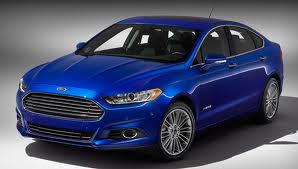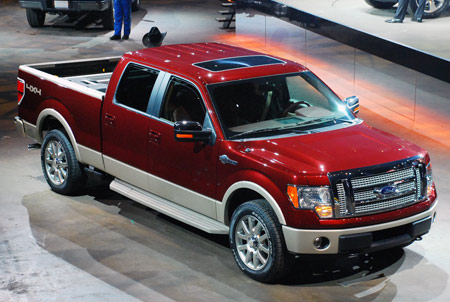Back in October, 2007, I wrote about the Toyota Prius and the GM Hummer in Prius v Hummer, the Battle for the Streets and the Prius v Hummer, the Battle for the Brains. (Spoiler alert – the Prius won). Now I’m thinking about Ford Motor Company. A few years back their tag line was “Ford Has A Better Idea.” That may not be the current tag line, but I think it is the case. I will go further and say that Ford is on the road to being Sustainable car company, and is a Value Investment.
While Toyota deserves credit for developing the hybrid- the Prius was introduced in 2000 – Ford has an extensive lineup of hybrids and is putting the EcoDrive – which boosts mileage by 20% – on vehicles, from small cars to the F150 truck. And 40% of the F150′s sold today are sold with the EcoDrive engine.
On April 12, 2012, Ford announced (here) that they will work with Dow Automotive, a division of Dow Chemical Company to push the state of the art in carbon fiber and other durable lightweight composites to reduce the weight of their products by up to 750 pounds, by 2020.
Is Ford Motor Company (F), driven by Bill Ford and Alan Mulally, a sustainable car company? Can it be sustainable? Or is it at best less unsustainable than its competitors in the automotive sector, aka the high speed, high convenience, moderate distance transportation sector? To be more circumspect, can Ford, as Steve Puma asked (Here) on Triple Pundit, in October, 2009, deliver on it’s sustainability promises? Does John Viera, Ford’s Global Director of Sustainability and Vehicle Environmental Matters, have power and influence? Is the “Eco Drive” real or greenwashing?
EcoDrive boosts mileage by 20%. That’s good. Ford doesn’t claim better. That’s also good. And 40% of the F150’s sold today are sold with the EcoDrive engine. That’s great.
Their efforts in this regard began in earnest when Executive Chairman and former CEO William Clay Ford remade the River Rouge plant into a test lab for sustainable manufacturing practices. They continued with CEO Alan Mulally. According to Mulally, “We are building these products in factories that are lean and clean. Between 2000 and 2010, we cut energy use at our global facilities by 40 percent, CO2 emissions by 49 percent and water use by 62 percent. A number of our facilities use power from solar panels, hydro-electricity, geothermal and wind. We are replicating many sustainable technologies first piloted at the Rouge Center.”
But if you think about sustainability in the context of the Brundtland Commissions canonical definition, “meeting the needs of the present without compromising the abilities of future generations to meet their needs,” and John Ehrenfeld‘s “flourishing forever,” Ford’s efforts can arguably be said to have begun when Henry Ford set out to build cars assembly line workers could afford to buy.
If they continue on this path and if Solazyme (SZYM) or another sustainable fuels companies succeeds in making cost effective gasoline from newly photosynthesized sugars, then they will be in a position to offer sustainable products manufactured in a sustainable manner.
Ford offers several hybrids, including the Escape Hybrid, popular as a taxi in New York City, and the new plug in ecodrive Fusion, which I would look at long and hard if I was buying a car. It might be a tossup between the Fusion Hybrid and the new Toyota Prius. Given that I am long on Ford (see disclosure, below) all things being equal, I’d buy the Fusion.
If Ford was to put the hybrid engine in the Mustang they would sell hybrids to middle aged guys who don’t “believe in” global warming, want to recapture their youth, but can’t afford or don’t want to pay $5 per gallon for gas in a car that gets 15 mpg. (Note that professing to not “believe” in global warming is professing to not “believe” in gravity. Gravity is there whether one “believes” in it or not. The question on global warming are “what happens, on a geologic scale, when we burn so much fossil fuel that we increase the amount of atmospheric carbon by about 35%?” If you say “nothing” you’re burying you head in the sand. And burying your head in the sand is a sure fire way of having your (dead) body follow your head – buried. But I digress….)
Is an investment in Ford a “Sustainable Investment?” And if so, is it an investment that the Value Investors would make?
According to their annual report, in 2011 Ford sold 5.7 million vehicles, up from 5.5 million in 2010. Ford’s net income was $20.21 Billion up from $6.56 Billion in 2010. This is delineated in table 1, below, and taken from the annual report, inside front cover.
| Operating Highlights | ||
| Units (thousands) | 2011 | 2010 |
| North America | 2,686 | 2,413 |
| South America | 506 | 489 |
| Europe | 1,602 | 1,573 |
| Asia Pacific Africa | 901 | 838 |
| Volvo | 0 | 211 |
| 5,695 | 5,524 | |
| Revenues (millions) | ||
| Automotive | $128,168 | $119,280 |
| Financial Services | $8,096 | $9,674 |
| Total | $136,264 | $128,954 |
| Net Income (millions) | $20,213 | $6,561 |
| Net income per share | $4.94 | $1.66 |
| Table 1, from Ford Annual Report | ||
I also compared Ford to other major car companies, in tables 2 and 3, taken from Google Finance page on Ford on 4/12/12.
Table 2 presents the basic financial data. Ford has a share price at $12.07 and earnings per share, EPS, at $5.01, Ford’s earnings multiple, P/E, therefore is 2.4. That seems to me to be a reasonable margin of safety when compared to Diamler, GM, Honda, Nissan, Toyota, and Volkswagon.
| Basic Financial Data | ||||||
| Symbol | Company name | Price | Earnings per share | P/E ratio | Mkt Cap ($Billions) | Dividend |
| F | Ford Motor Co | 12.07 | 5.01 | 2.41 | 46.1 | 0.05 |
| DDAIF | Daimler AG (USA) | 55.45 | 6.16 | 8.99 | 59.1 | 2.43 |
| GM | General Motors | 24.3 | 4.58 | 5.3 | 38.1 | 0 |
| HMC | Honda Motor Co. Ltd. | 36.56 | 1.27 | 28.89 | 65.9 | 0.67 |
| NSANY | Nissan Motor Co., Ltd. | 20.78 | 1.76 | 11.83 | 43.3 | 0.25 |
| TM | Toyota Motor Corp. (ADR) | 83.01 | 1.48 | 56 | 130.2 | 1.24 |
| TSLA | Tesla Motors Inc | 33.44 | -2.52 | 3.5 | 0 | |
| VLKAY | Volkswagen AG (ADR) | 31.45 | 8.68 | 3.62 | 73.2 | 0.79 |
| Table 2, from Google |
||||||
Looking at other financial metrics, Table 3, below, Ford has a high debt to asset ratio, 55.78, but also has a high return on average asset ratio, 11.79, net profit margins of 14.84, operating margin of 5.6, and return on average equity of 281.62. Altho Volkswagon and Daimler have higher operating margins, Ford has highest net profit margin, highest return on average assets, and highest return on equity of the automotive sector, and the lowest price earnings ratio (except for Tesla motors, which as a start-up is operating at a loss and therefore has an undefined price earnings ratio).
| Financial Ratios | ||||||
| Symbol | Company name | Total debt to assets | Return on avg assets | Return on avg equity | Net profit margin | Operating margin |
| F | Ford Motor Co | 55.78 | 11.79 | 281.62 | 14.84 | 5.6 |
| DDAIF | Daimler AG (USA) | 39.52 | 3.53 | 13.5 | 4.78 | 7.29 |
| GM | General Motors | 9.22 | 4.3 | 28.35 | 4.06 | 3.78 |
| HMC | Honda Motor Co. Ltd. | 35.66 | 3.65 | 12.17 | 4.74 | 6.38 |
| NSANY | Nissan Motor Co., Ltd. | 37.99 | 3.32 | 11.29 | 3.97 | 5.28 |
| TM | Toyota Motor Corp. (ADR) | 41.59 | 0.83 | 3.95 | 1.32 | 2.47 |
| TSLA | Tesla Motors Inc | 39.27 | -46.28 | -118.03 | -124.56 | -123.13 |
| VLKAY | Volkswagen AG (ADR) | 36.88 | 6.98 | 29.77 | 9.92 | 7.07 |
| Table 3, from Google |
||||||
As discussed here, Ford didn’t take TARP money, but clearly benefited, albeit indirectly, along with every other business in the mid-west, if not the entire country, with the US government’s successful bailout of GM and Chrysler.
I think an investment in Ford at this time is both an investment in sustainability and a value investment. Re “Sustainability, Ford is reducing it’s carbon, energy and water footprints in manufacturing, engaged in profit sharing with the UAW, and building more efficient vehicles. As far as Ford being a “Value Investment” it’s Return on Assets, Average Equity, and it’s Net Profit and Operating margins are high for the automotive sector. At the same time, it seems that its price / earnings ratio is very low for the sector and thus, it seems to me that there is a substantial margin of safety.
DISCLOSURE
While I haven’t driven a Ford lately, I am long on Ford and Solazyme.
This should not be construed as investment advice. While I have an MBA in Managing for Sustainability, from Marlboro College, 2010, I am not a licensed investment adviser, nor am I currently employed in the financial services industry.
I’m currently driving a ’99 Chevy Malibu w 164,000 miles. I’ve driven two Mercury Sables, a ’90 Sable and a ’99 Sable. I owned each of them for over 10 years and over 150,000 miles, and found them to be reliable, altho the heater core failed on the ’99 after 10 or 11 years and somewhere north of 150,000 miles.
Other Links
Ford Annual Report
Ford: Green Technology
Bill Ford Jr., Building a Sustainable Future for Ford Motor Company
McKinsey Quarterly, Building a sustainable Ford Motor Company: An interview with Bill Ford, (Abstract and link to paid report)
Triple Pundit, Can Ford Motors deliver on its Sustainabiliity Promises?
What Drives Sustainability at the Ford Motor Company?

